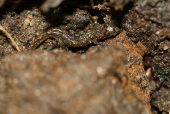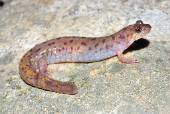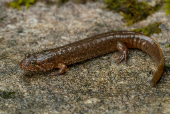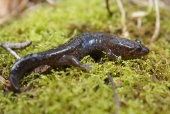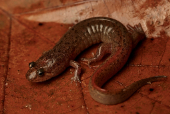Seal Salamander (Desmognathus monticola)
Description: The seal salamander is a fairly robust species that ranges in color from tan to dark brown. The patterning of the back is highly variable and may range from well-defined light spots to a dark splotchy or net-like pattern. The belly is light and unmottled with little or no flecking. Larvae and juveniles tend to be more boldly patterned with well-defined pairs of spots down the back.
Habitat: Its habitat includes rocky mountain streams, spring-fed brooks in the ravines of deciduous forests, muddy sections of streams and seepages.
Range: The seal salamander can be found from southwestern Pennsylvania and south through Appalachian Mountains areas of high elevation in West Virginia, western Maryland, western and northern Virginia, eastern Kentucky, western North Carolina, eastern Tennessee, western South Carolina, and northern Georgia to central Alabama. In the north of its range, it has not been observed north or west of the Ohio River. An introduced population is present in Benton County, Arkansas.
Diet: Seal salamanders primarily comsume small aquatic and terrestrial invertebrates. Larger individuals will consume larger prey items. Seal salamanders will occasionally consume smaller salamanders.
Reproduction: Females typically lay eggs in or around running water and guard them until hatching. Young seal salamanders overwinter as larvae and metamorph into adults during the spring. Larval seal salamanders have external gills are fully aquatic while metamorphosed individuals tend to occupy the stream margins and move between aquatic and terrestrial habitat.
Status: Listed as Least Concern in view of its wide distribution and presumed large population.
Taxonomy: Desmognathus monticola will be split into Desmognathus monticola and Desmognathus cheaha.
»» Kingdom: Animalia - Animals
»» Phylum: Chordata - Chordates
»» Subphylum: Vertebrata - Vertebrates
»» Class: Amphibia - (Amphibians)
»» Order: Caudata - Salamanders
»» Family: Plethodontidae - Lungless Salamanders
»» Genus: Desmognathus
»» Species: Desmognathus monticola - Seal Salamander
This article uses material from the Wikipedia article "Seal Salamander", which is released under the Creative Commons Attribution-Share-Alike License 3.0. Content may have been omitted from the original, but no content has been changed or extended.
|



